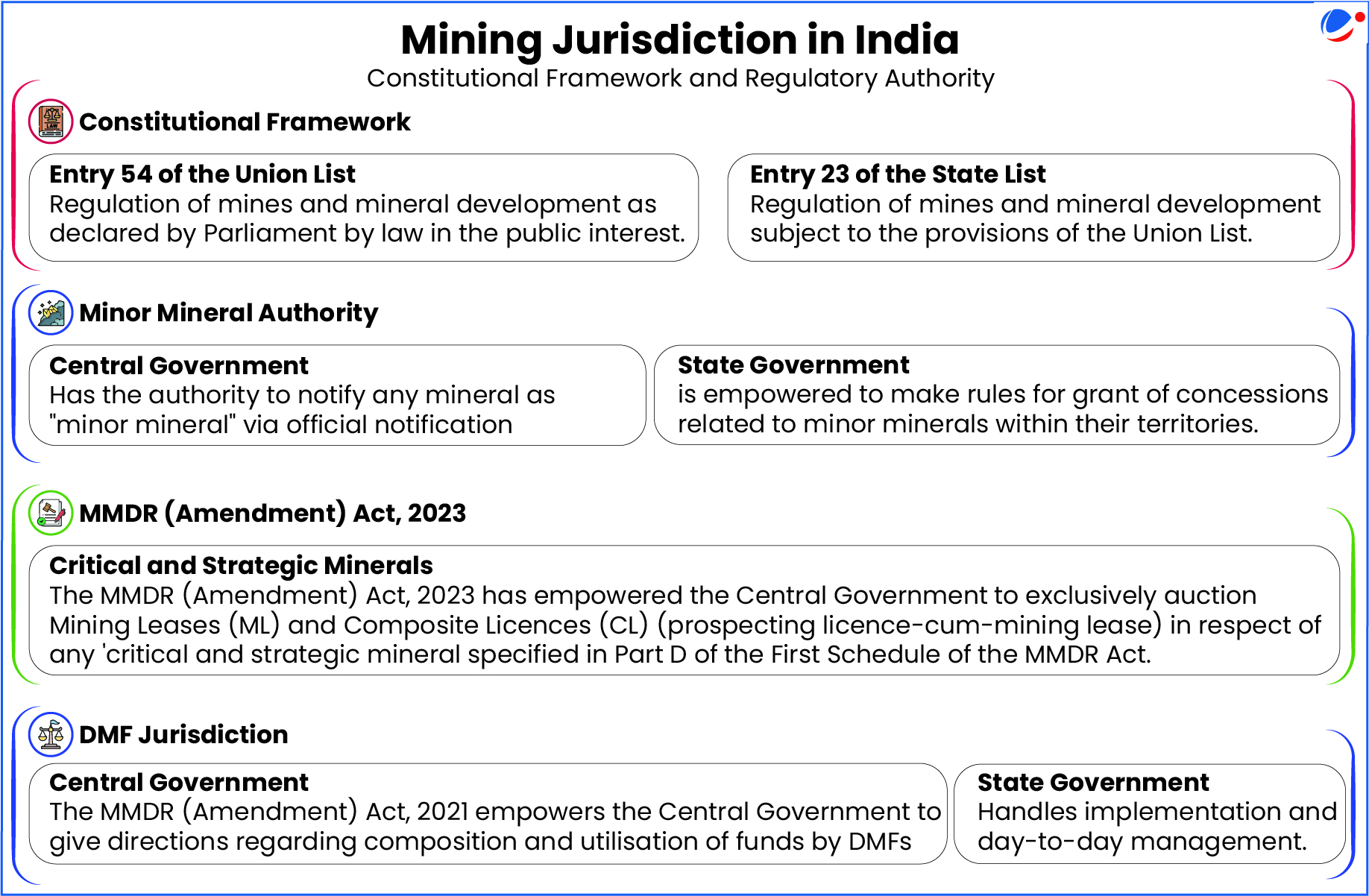Why in the News?
A report was placed in the Parliament by the Standing Committee on Coal Mines and Steel reviewing the implementation of the DMF Fund and the Pradhan Mantri Khanij Kshetra Kalyan Yojana (PMKKKY) in India.
About District Mineral Foundation (DMF)
- Enactment: Created in 2015, via an amendment to the Mines and Minerals (Development & Regulation) Act, 1957
- Concept: The DMF is a non-profit statutory 'Fund' for every Indian district affected by mining related operations. It is set up as a non-profit trust.
- Objective: To work for the interest and benefit of persons, and areas affected by mining related operations in such manner as may be prescribed by the State Government.
- Structure of DMF: Two-tier administrative setup: -
- As per MMDR Act, 1957, the State Governments are empowered to make rules prescribing the composition and functions of the District Mineral Foundation.
- DMFs function through a 2-tier administrative set-up comprising of:
- Governing Council (GC)– Policy-making body.
- Managing Committee (MC)– Executes projects and schemes.
- Funding of DMF
- Funded by mining leaseholders as a percentage of royalty as prescribed by the central government:
- 10% of royalty for leases granted on or after 2015.
- 30% of royalty for leases granted before 2015.
- The contribution of mine lease holders to DMF differ from mineral to mineral as it is charged as percentage of royalty and royalty differ from mineral to mineral but not mine to mine.
- Utilization of Funds: Funds must be spent at the district level under the PMKKKY guidelines.
- Funded by mining leaseholders as a percentage of royalty as prescribed by the central government:

- Significance and status:
- Tied to participatory governance laws: Functioning of DMF is also guided by 5th & 6th Schedules of the Constitution (tribal areas); Panchayats (Extension to Scheduled Areas) Act (PESA), 1996; Forest Rights Act (FRA), 2006.
- 645 districts (23 States) have DMFs.
- Over ₹1-lakh crore collected in the past decade.
- Top states by DMF funds: Odisha (29%); Chhattisgarh (14%); Jharkhand (13%)
Pradhan Mantri Khanij Kshetra Kalyan Yojana (PMKKKY)
|
Challenges Associated with the District Mineral Foundation (DMF)
- Governance Issues:
- Dominance of Officials: DMFs are largely controlled by district collectors (DCs), with little mining community representation. E.g., Only five states include affected people in Governing Councils (iForest report).
- Lack of Independence: DCs are chairpersons of both Governing Councils (GCs) and Managing Committees (MCs), limiting independent decision-making (Parliamentary Committee Report).
- Lacks Planning and Beneficiary Identification: No district has published a five-year perspective plan.
- E.g., lack of Gram Sabha engagement (reflecting a top-down approach) in decision-making. (Parliamentary Committee Report)
- Fund Utilization Challenges:
- Low Spending: Only 40% of accrued funds have been utilized, reflecting delays in project execution. For instance, utilisation in major DMF states, e.g., Jharkhand, Odisha & Rajasthan is quite low. (iForest report).
- Imbalanced Allocation of DMF Funds: The funds favour physical infrastructure over human development thereby contradicting PMKKKY's goal to address poverty and deprivation.
- E.g., In 11 states, over 30% of DMF funds are allocated to infrastructure (iForest report)
- Weak Grievance Redressal & Monitoring: Most districts lack functional complaint systems, with no public data on resolutions.
- E.g., Absence of a DMF fund utilization index hinders transparency in fund utilization (Parliamentary Committee Report).
- No Social Audits: DMFs have not conducted social impact assessments to evaluate the effectiveness of their investments on beneficiaries (iForest report)
- Gap in Achieving PMKKKY Goals in Aspirational Districts: Of the 112 ADP districts, 106 are DMF districts, yet key PMKKKY objectives like mitigating mining impacts remain unmet. (Parliamentary Committee Report).
Reforming District Mineral Foundation (DMF) Governance & Implementation
- Governance Reforms:
- Ensure DMFs operate as independent, community-led institutions, not as extensions of district administrations. E.g., Actively engage Gram Sabhas.
- There can be at least 1/3rd representation of mining-affected communities in the GC and MC.
- Participatory Planning & Long-Term Vision: All DMFs can develop comprehensive five-year plans based on community consultations.
- Plans should align with district development goals but prioritize the needs of mining-affected populations.
- Strict Enforcement of PMKKKY Guidelines: At least 70% of DMF funds must be allocated to critical sectors. E.g., Healthcare, Education, Livelihoods & Skill Development and Drinking Water & Sanitation.
- State governments must comply with national PMKKKY guidelines.
- Mandatory Social Audits & Financial Reviews: 3rd Party independent agencies may conduct regular audits.
- CAG may perform periodic evaluations of DMF spending and impact.
- Focus on 'Just Transition': E.g., Endowment Funds for Post-Mine Economies to support communities in regions where mining is ceasing.
Conclusion
A decade after its creation, the DMF remains a work in progress. The problem is not a lack of funds but a lack of vision and political will to ensure the DMF serves its intended purpose. For the DMF to truly fulfil its mandate, we need urgent, systemic changes that put communities at the centre of decision-making.



